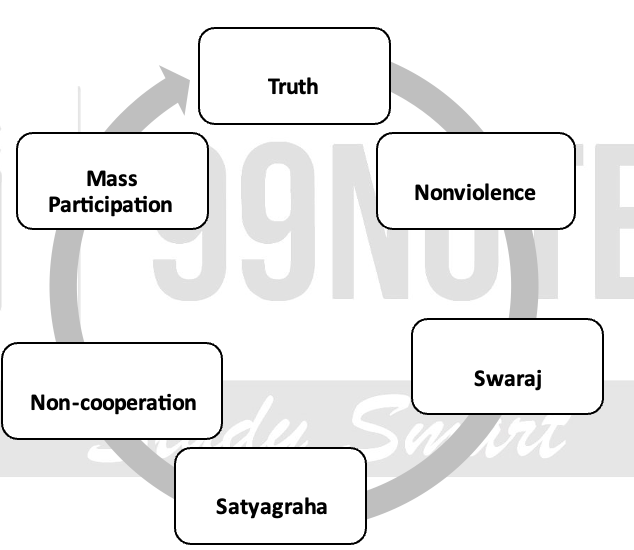Quit India movement, Independence plans, Partition of India, Constituent Assembly and Indian Independence Mains Test
Mains Test Series
Quit India movement, Independence plans, Partition of India, Constituent Assembly and Indian Independence.
Q. The August movement was completely un-Gandhian in its form and intention. Critically analyse. (250 words)
Introduction
In July 1942, the Congress working committee met at Wardha and adopted the ‘Quit India Resolution’ authorising Gandhi to take charge of the mass movement. The resolution was to be approved by the AICC meeting in Bombay in August.
On 8 August 1942, the AICC ratified the Quit India resolution in its meeting at Gowalia Tank Maidan, Bombay.
Gandhian method of movement:
Methods used in the Quit India movement 
- Parallel Governments: This was a unique feature of the Quit India movement, which was never observed in any earlier Gandhian movements. It demonstrated the support of ordinary people towards the indigenous institutions and structure of power. Parallel governments in the following places:
- In Balia, in Eastern Uttar Pradesh, a parallel government was formed under Chittu Pandey.
- The Jatiya Sarkar was established in Tamluk in the Midnapur district of Bengal.
- ‘Azad Government’ in Ahmedabad and one formed by
Rammanohar Lohia on the Nepal border.
- Underground Activities: An underground network was being consolidated in the various parts of the country, which was another exceptional feature of this movement.
- For example, In Bombay, a Congress Radio was operated by Usha Mehta, whose broadcast could be heard as far as Madras.
- The underground activities involved disrupting communications by blowing up bridges, cutting telegraph and telephone wires and derailing trains. There were also some instances of attacks on police and informers.
- The violent nature of the movement:
- In some places, huge crowds attacked police stations, post offices, courts, railway stations and other symbols of government authority, and forces were used hugely.
- National flags were forcibly hoisted in several places.
- The greatest level of violence occurred in Bihar and the eastern United province.
- Radical initiatives:
- It was the most radical and violent of all the previous struggles.
- The absence of the arrested political elite at the forefront is why the movement was less conservative. The movement was in the hands of the subaltern class.
- For example :
- Leaders like Gandhi, Nehru, Patel, and others were detained.
- C Rajagopalachari resigned because he did not support complete independence.
- Unlike the previous movements, which were more prominent in urban areas, this time, the labour class and poor, who were hit hardest by the rising inflation and food shortage, participated enthusiastically.
However, there were some Gandhian features too in the Quit Indian movement:
- Nyayadan Mandals were organised to provide justice, Prohibition was enforced, and ‘Gandhi marriages’ (inexpensive and invitation to untouchables) were organised in the Satara.
- Even Gandhiji refused to condemn the violence by the people as he argued that it was a reaction to much bigger violence by the state.
- Many people in the Congress, including some staunch Gandhians, believed that the peculiar circumstances warranted the use of violence.
- Some believe that there is nothing wrong with sabotaging communication lines or blowing up bridges if it does not cause loss of human life.
- Mass Participation in the Quit Indian movement is the most significant feature. The ordinary people showed unparalleled heroism.
- The ultimate aim of the movement was to attain Swaraj following the path of
Conclusion
The Quit India Movement put the demand for complete independence as the immediate agenda of the movement, a brainchild of Mahatma Gandhi. Therefore, his role cannot be denied. After this movement, there was no turning back, and future negotiations with the British would involve nothing less than complete independence.
Upload Answer here
For Enquiry

Quit India movement, Independence plans, Partition of India, Constituent Assembly and Indian Independence Mains Test

GoI act, 1935, Poona Pact, Forward Block, communists and socialists, Politics before World war II Mains Test

Revolutionary Activities, Constitutional reform demands and its politics, Civil Disobedience. Mains Test

Montague-Chelmsford reforms, Non-cooperation movements and its aftermath, Temple entry movements and local revolts Mains Test

Congress split and reunion, Advent of Gandhi, Local Satyagrah till Rawlatt Mains Test

13 September 2023 : Daily Answer Writing

13 September 2023 : Daily Quiz

12 September 2023 : PIB

13 September 2023 : The Hindu Editorial Notes PDF

13 September 2023 : Indian Express
